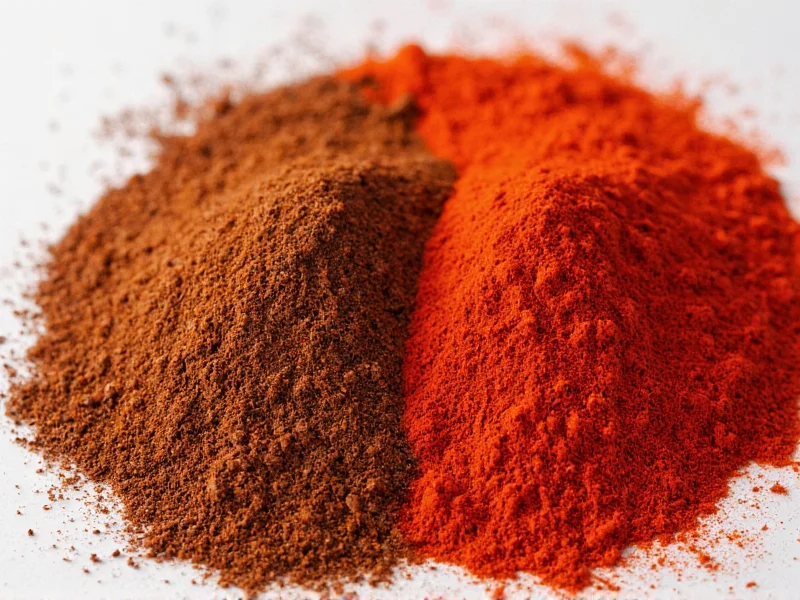Understanding the difference between cayenne pepper and paprika is essential for home cooks and culinary enthusiasts who want to achieve authentic flavors in their dishes. Though they may appear similar in their red powder form, these spices come from different pepper varieties and serve distinct purposes in cooking.
Origin and Ingredients: What Makes Each Spice Unique
Cayenne pepper is made from Capsicum annuum varieties that are specifically cultivated for heat. The peppers are dried and ground into a fine powder, resulting in a consistent fiery spice. True cayenne comes from specific hot pepper varieties that maintain their intense heat profile.
Paprika, however, has a much broader definition. It's made from various Capsicum annuum peppers that can range from sweet bell peppers to moderately hot varieties. The specific peppers used determine paprika's final characteristics. Hungarian paprika, for example, comes from specific sweet pepper varieties grown in Hungary, while Spanish paprika (pimentón) can be made from peppers that are smoked over oak fires.
Heat Level Comparison: Understanding the Scoville Scale Differences
The most dramatic difference between these spices is their heat level. This distinction is crucial when considering whether you can substitute paprika for cayenne in recipes.
| Spice Type | Scoville Heat Units | Heat Level Description |
|---|---|---|
| Cayenne Pepper | 30,000-50,000 SHU | Intensely hot, sharp burn that lingers |
| Sweet Paprika | 0-100 SHU | No heat, purely for color and flavor |
| Hot Paprika | 500-1,000 SHU | Mild to moderate warmth, not comparable to cayenne |
| Smoked Paprika | 100-2,000 SHU | Varies by type, but significantly milder than cayenne |
When exploring what makes cayenne pepper hot, the answer lies in its high capsaicin content. Capsaicin is the compound responsible for the burning sensation, and cayenne contains significantly more than even the hottest paprika varieties. This fundamental chemical difference explains why these spices cannot be used interchangeably without adjusting quantities.
Flavor Profiles: Beyond Just Heat
While heat is the most obvious difference, the flavor profiles of these spices vary considerably:
- Cayenne pepper: Sharp, pungent, with a one-dimensional heat focus. It adds fire without significant flavor complexity.
- Sweet paprika: Earthy, slightly sweet, with notes of dried fruit and pepper. Provides rich color without heat.
- Smoked paprika: Complex smoky flavor with varying heat levels (sweet, medium, or hot varieties).
- Hungarian paprika: Distinctive sweet and slightly pungent flavor with eight official classifications based on heat and flavor.
Professional chefs emphasize that substituting cayenne for paprika (or vice versa) dramatically alters a dish's character. As one culinary expert notes, 'Using cayenne when a recipe calls for paprika transforms a dish from subtly seasoned to overwhelmingly hot, while using sweet paprika when cayenne is required leaves the dish lacking its intended fiery kick.'
Can I Substitute Paprika for Cayenne? Practical Cooking Guidance
The question of whether you can substitute paprika for cayenne is one of the most common concerns among home cooks. The answer depends on which type of paprika you have and what you're cooking:
- Using paprika instead of cayenne: Only hot paprika can partially substitute for cayenne, but you'll need 2-3 times the amount to achieve similar heat. This will also introduce different flavor notes. Sweet paprika won't provide any comparable heat.
- Using cayenne instead of paprika: This requires extreme caution. Start with 1/8 teaspoon of cayenne for every tablespoon of paprika called for, then adjust carefully. The dish will be significantly hotter with less color and different flavor.
For those wondering about sweet paprika vs cayenne pepper, these represent opposite ends of the spice spectrum. Sweet paprika adds color and mild flavor without heat, while cayenne exists primarily to add heat with minimal flavor complexity.
Nutritional Differences Worth Noting
Both spices offer health benefits, but their nutritional profiles differ due to their heat levels:
- Cayenne pepper: Higher in capsaicin, which may boost metabolism, reduce appetite, and provide pain relief. Contains significant vitamin A and C.
- Paprika: Rich in antioxidants like capsanthin (which gives it color), vitamin A, and vitamin E. Sweet paprika contains more vitamin C than cayenne due to lower processing temperatures.
The difference between cayenne pepper and paprika extends to their potential health effects. Cayenne's high capsaicin content creates the thermogenic effect many associate with metabolism boosting, while paprika's antioxidant profile supports eye health and immune function without the intense heat.
Common Misconceptions Explained
Several misconceptions cause confusion between these spices:
- Misconception: All red pepper powders are the same
Reality: The color comes from similar plant compounds, but the specific peppers and processing create vastly different products. - Misconception: Paprika is just mild cayenne
Reality: They come from different pepper varieties bred for specific characteristics. - Misconception: Red pepper flakes are the same as cayenne
Reality: Red pepper flakes typically contain a mix of辣椒 varieties and are less consistently hot than pure cayenne powder.
Understanding these distinctions helps explain why professional recipes specify particular types of paprika or cayenne. The question 'are red pepper flakes the same as cayenne' often arises from similar confusion about red-colored spice products.
When to Use Each Spice: Culinary Applications
Knowing when to reach for cayenne versus paprika transforms your cooking:
- Cayenne pepper shines in:
- Hot sauces and salsas
- Creole and Cajun dishes
- Spicy marinades
- Adding heat to soups and stews
- Commercial snack seasonings
- Paprika excels in:
- Hungarian goulash and stews
- Spanish paella and chorizo
- Deviled eggs and potato salads
- Meat rubs for color and flavor
- Adding color to dishes without heat
Mastering the difference between cayenne pepper and paprika allows you to control both the heat level and flavor profile of your dishes with precision. Whether you're wondering 'is cayenne pepper spicier than paprika' or need guidance on substitutions, understanding these fundamental distinctions elevates your cooking from accidental to intentional.











 浙公网安备
33010002000092号
浙公网安备
33010002000092号 浙B2-20120091-4
浙B2-20120091-4